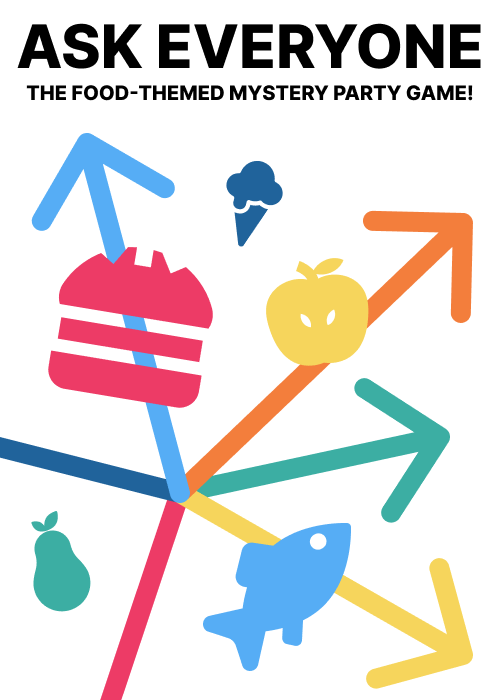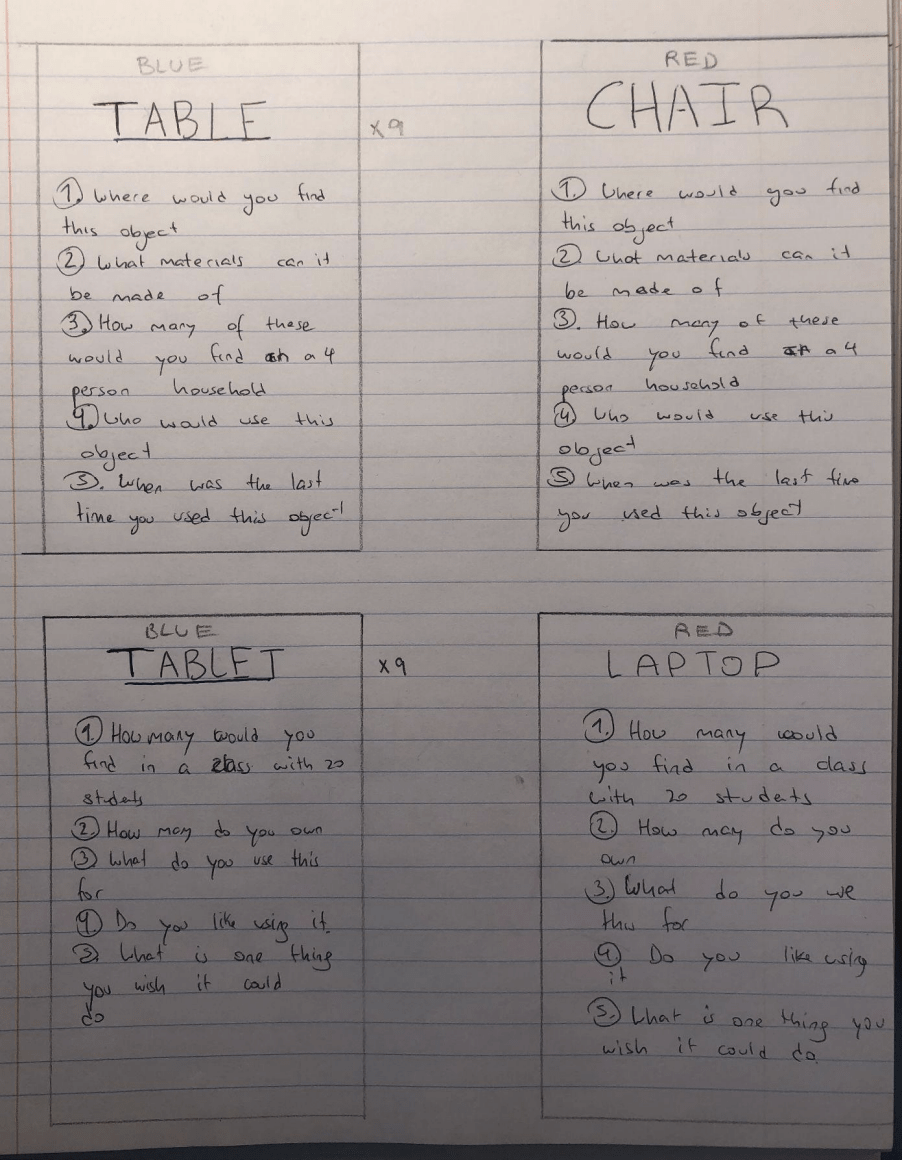Ask Everyone: The Food-Themed Mystery Party Game!
Our Mission
Some of our fondest memories are late nights playing identity games with friends — Avalon, Secret Hitler, Among Us — the list goes on. But we’ve often struggled to find people to play with. Why? Well, when players get into identity games, tensions can run high, and this sometimes makes identity games a little bit, well, awkward to play with new friends. We want to be able to play with lots of people! We want to have fun with our workmates, classmates, and those nice acquaintances we bump into every so on.
So we sat down and thought — how can we create an identity game that everyone can enjoy, even with strangers? Our ideas pored forth like hotcakes but none of them seemed worth their salt. We were in a bit of a pickle. Maybe, we thought, we bit off more than we could chew. Then, one afternoon, as we were packing up to grab dinner we realized — why not make an identity game about food? What could be better at bringing people together and making people smile? We tried playing our new game — and it just melted in our mouths. A little buttering up, a little garnish, and our game was ready to serve! We hope you and your friends go bananas playing just as much as we did!
Concept Map
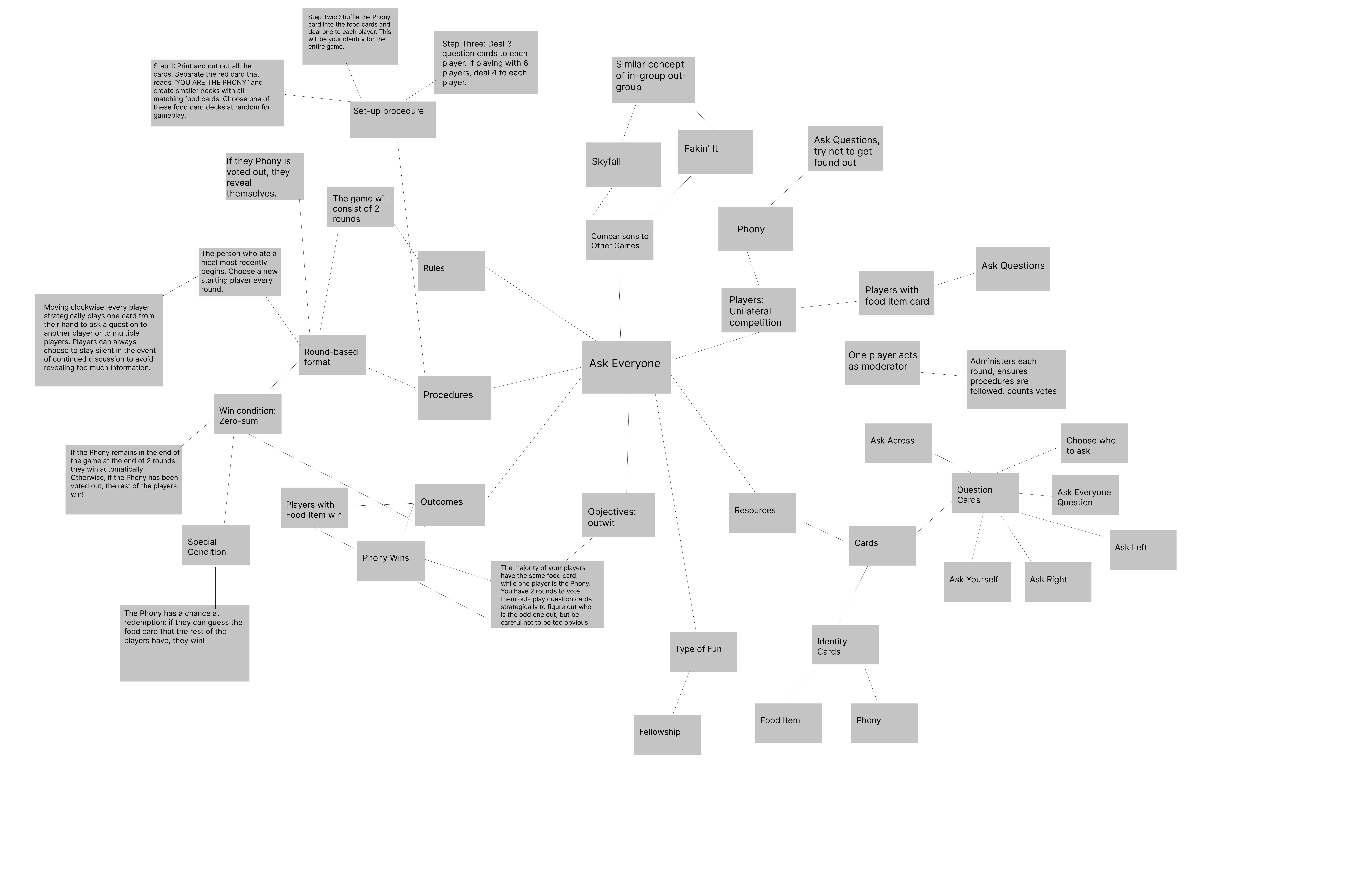
Link to Figma File for better viewing
Initial Game Decisions
When we first sat down to make a game, we quickly realized that we all wanted to make a team versus team identity game. In our initial game, one player would be randomly chosen to be a phony. The other players would not know the identity of the phony and their objective would be to determine the identity of the phony. The phony’s objective would be to not reveal their identity. Furthermore, the other players would know a secret object (randomly chosen from a finite list). The phony would not know this secret object but would know a similar object (e.g. computers and tablets, tables and chairs). To prevent the other players from simply revealing the secret object outright, the phony would have a second possible objective — to learn what the secret object is. If the phony accomplishes either of their objectives — avoiding detection or identifying the secret object — then the phony would win. Players would discuss pre-determined questions each round and once two minutes are up, the round would be over and they must vote out one player. Each game would consist of two rounds, thus giving the players two chances to vote out the phony.
First prototype:
Testing and Iteration History
We conducted three unique playtests when designing our game. The first and third playtests were during class and the players were other members of our class. We conducted the second playtest in our assigned section with classmates in our same section. The first and second playtests each involved six players and the third playtest involved five players.
When we conducted our first playtest, we quickly determined that the pre-determined questions were too specific and not helpful. Also, since they went clockwise answering the same question, players would copy what others said, making it extremely easy for the phony to hide. After two rounds, we quickly changed our game on the spot by saying players could ask each other any questions. However, players were very quiet for most of the game. They took around 10 or 15 seconds to ask another player a question and never interrogated each other on their answers. They only communicated minimally with each other to keep the game moving and didn’t strategize at all. Both times they voted players out, we noticed they simply voted for the players who happened to be asked the most questions. One player was not asked any questions at all.
When we debriefed, we asked players why they didn’t talk much while playing. One player told us that they didn’t want to come off as too aggressive since they didn’t know the other players, and so they decided to stay quiet. The other players concurred — we realized that this was a major problem we had to address.
We held two team meetings the next day to go over our findings and brainstorm how we could fix our game. We realized that players needed to feel safe and comfortable enough asking other players questions. When they had the freedom to come up with any questions they wanted, they biased towards asking simple questions and spent a lot of time thinking of how to ask questions non-aggressively. To address this problem, we added a new mechanic to our game. Instead of allowing players to come up with any questions they wanted, we decided to give players pre-determined questions. Players would each draw four random question cards from a stack of question cards and could only ask each other questions on their cards. Each time they played a card, they could draw one more, keeping them at four question cards. This was different then our first playtest because here each person had to answer a different question and could not copy others.
When we conducted our second playtest, we noticed that players were significantly more lively than before. We moderated two games and in each game, players asked a lot more questions to each other than in our first playtest. However, in both games, the phony evaded detection. When debriefing after our playtest, players told us that they didn’t want to seem like they were piling on other players, so they tried to ask other players evenly, even if it was not strategic. This gave the phony a huge advantage.
Back to brainstorming. We met as a team and, after experimenting among us with different mechanics, decided to add another condition to each question card. Each question card would list a certain player they could ask. There would be six possibilities: ask the player to the immediate left, ask the player to the immediate right, ask the player directly across, you answer the question yourself, ask any player of your choosing, and ask all players. We designed this mechanic to give each player plausible deniability for piling on players who acted suspiciously. Players could simply claim that they didn’t have any other option but to ask the player they thought was suspicious since they could claim that they only had that question card.
We had one lingering hesitation about making this change. Our initial goal was to make a game that anyone could enjoy, even strangers. We wanted to avoid making a game that encouraged players to act too aggressively, as that might turn some players off. Since our mechanics change lowered the barrier for players to pile on each other, we worried that some players might become too aggressive and turn others off. To help alleviate this problem, we decided to give our game a fun, light-hearted theme, to normalize a fun and light-hearted play style. After a lot of thought, we were still a bit stuck and we decided to take a break for dinner. Then it hit us — why not make our game theme about food? Each game object would be an item of food, such as sushi, hamburgers, and ice cream.
With a decided theme, it was also time to think about the visual design of our game. These were some of the considerations we had:
- Family-friendly vibe (colors/icons)
- Motif of arrows/icons everywhere
- High readability (big font)
- Distinct colors/icons on question cards
- Icons on all 4 corners
- White/black cards for deck separation
- Food cards in sets of colors to ensure sets stay together
- Color identification of phony
We first came up with this design and were off to playtest!
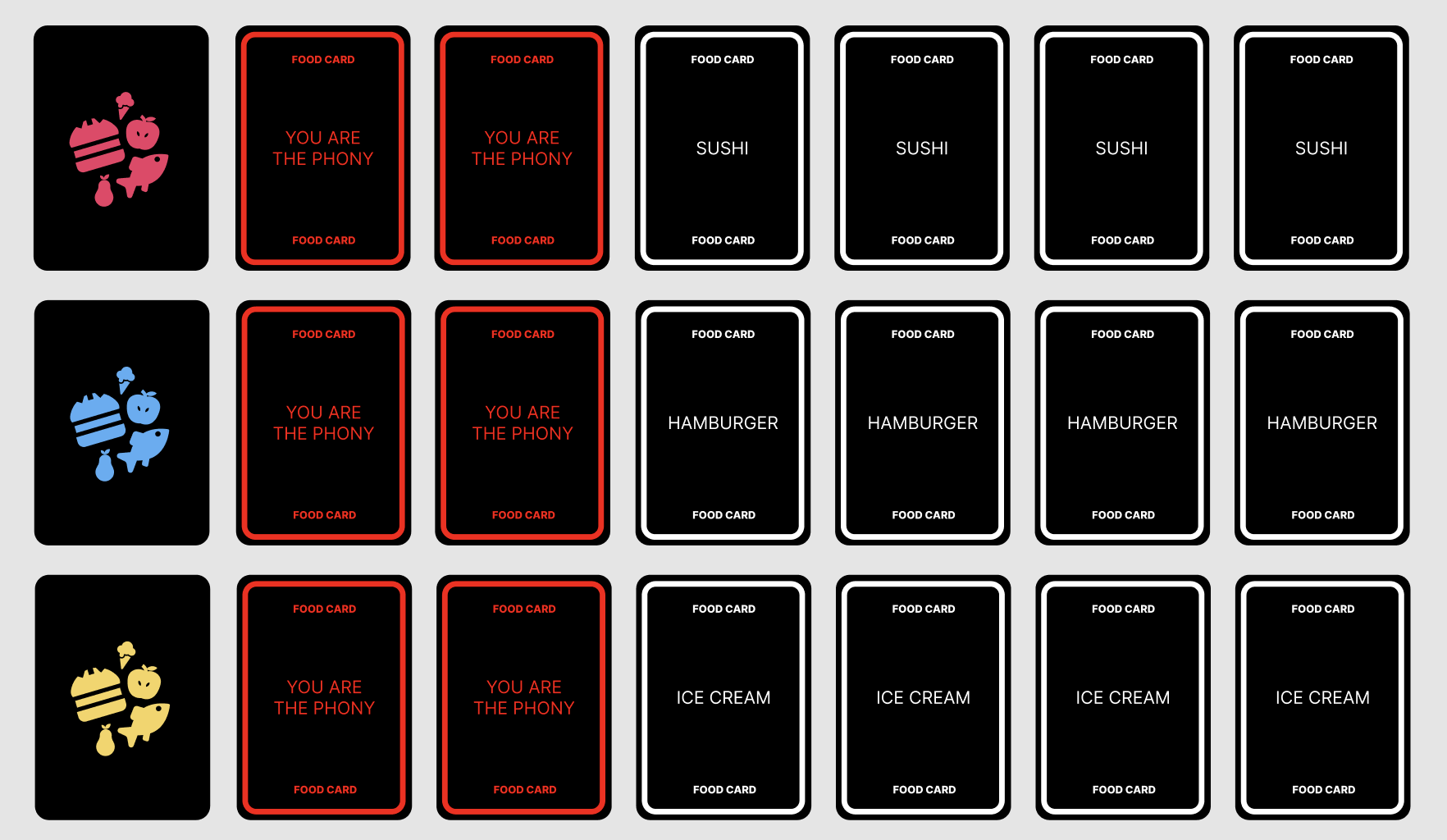
First design of our food and phony cards
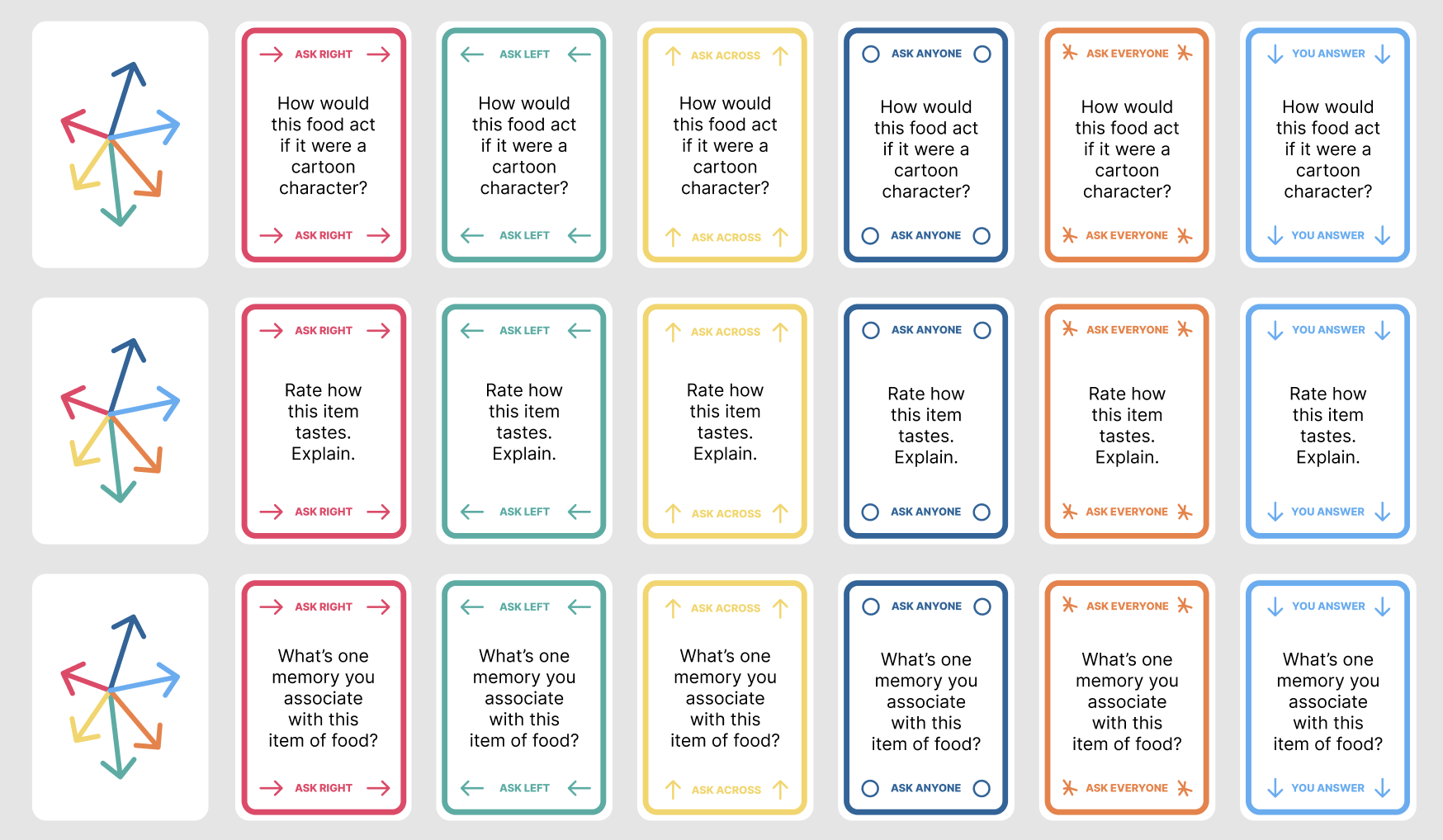
First design for question cards
On to our third playtest. We were nervous going in — we were running out of time. But, to our excitement, players got into it! They began to strategize about which cards to play and chose to question players who they thought were suspicious. As they mimed using chopsticks to eat sushi, the table erupted in laughter. They began to talk more animatedly with each other as they tried to discern the phony — and to our relief, the atmosphere stayed light-hearted. In our debriefing, the feedback was very positive — one player explicitly told us that they had a lot of fun playing the game. It seemed as if our game perfectly fit the “Fellowship” type of fun we were planning for. There was still polishing to be done — specific question cards to be revised, icons to be made more clear — but the mechanics seemed solid.
For example, we noticed that players played many “ask everyone” questions which revealed too much information for the Phony who easily guessed the food item. To fix this, we decided to include fewer “ask everyone” questions in our set. Players also said that the questions were too repetitive. Initially, we had thought of putting each question on all 6 question types cards. However, this meant that each question would appear 6 times and would therefore be too repetitive. To fix this, we limited each question to only appear on a subset of question-type cards and also added several more questions. Finally, we incorporated some feedback from our TA and added a few “blank” cards that allowed players to come up with their own questions. We think this would add an element of unpredictability and make the game even more engaging. However, we also remembered from our first playtest that too much flexibility is worse since players are afraid to ask questions, so we limited the number of blank cards in our set.
We also received some feedback on our visual design. The biggest issue was the contrast of our “Phony” card. The red on black made it hard to read, so we decided to change the background to white. We had also printed the cards too small, which made it hard for players to hide. We decided to make them a bit larger and adjusted the dimensions to make the print-n-play pdf as easy to cut up as possible.
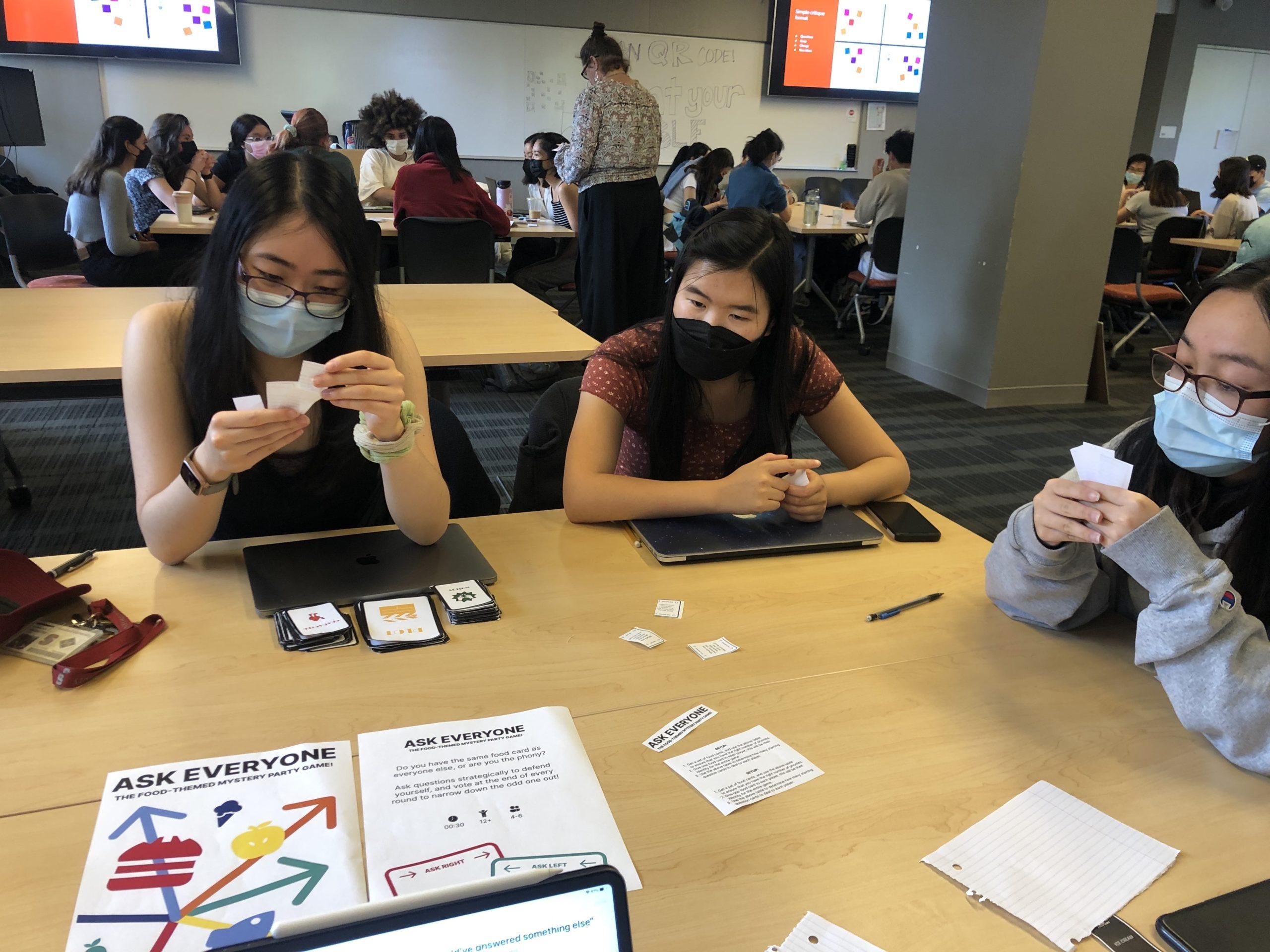
Third playtest session – in class
We spent the next couple of days polishing — and, finally, we could say that we were happy with our game! It was a long process of brainstorming, playtesting, and iteration — and it wasn’t always straightforward. In fact, multiple times we found ourselves going back to the drawing board to revise core elements of our game, including both key mechanics as well as our game’s theme itself. We would playtest and then realize that we needed to brainstorm some more. We became very discouraged after our first playtest and almost abandoned our game entirely — and, looking back, we are very glad that we stuck with it! We hope to polish our game even further after this class and have fun playing it with family and friends. One of the biggest issues we still plan to target is replayability. Since our game mechanic relies on the phony not knowing the food item, if several rounds are played, players will slowly start to learn all of them. Some ideas we had to fix this were:
- Adding many (~100) food items (perhaps adding a digital component to alleviate the number of cards and to make it easier to assign identities)
- Having a blank set where a moderator can come up with a food item for each round.
Although they seem to help fix the problem, we would still have to playtest more!

Final Playtest
Final Prototype and Design
Print-n-play version:
Box Design:
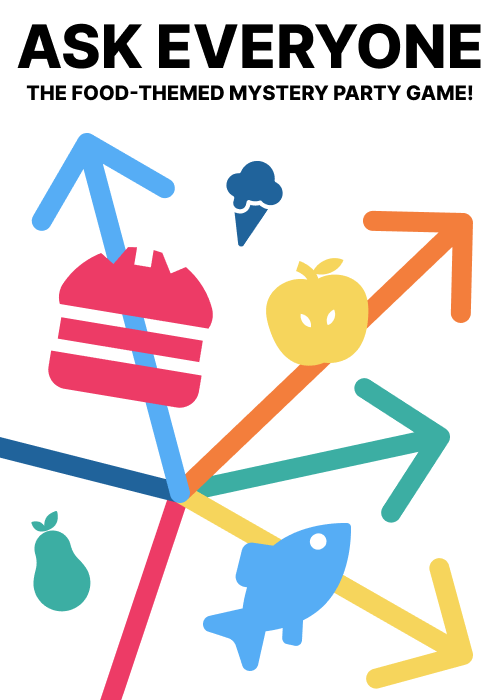
Box Front
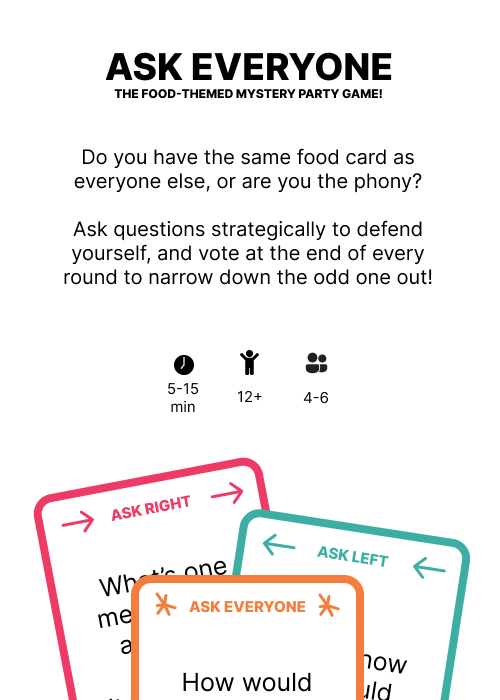
Box Back


